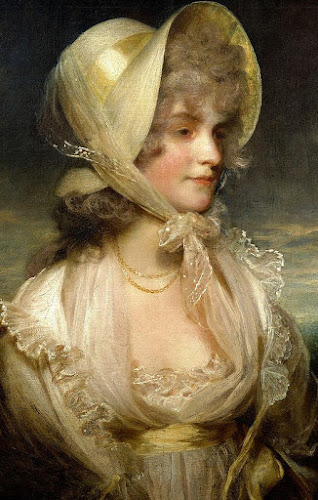Apologies all around for not writing more frequently on my blog -- something I'm determined to correct in the coming weeks. Today I'm going to talk about my main character, Miss Julia Charlotte Montford, the heroine of Wicked Wagers, due to release in October of this year.
Julia is a feisty one -- spoiled, often impudent, headstrong and all too often making wagers. If she lived in today's world, she'd probably be buying lottery tickets by the yard! But one day she makes a wager with the ex-cavalry officer, Benjamin Malory Burton, and her life will never be the same.
Oftentimes we writers scour the internet and sites like Pinterest to find an image that sparks the imagination of both the writer and the reader. Many times it's an actress or actor, but this time I stumbled on a series of paintings by John Hoppner, who lived and painted in the late 18th century into the early years of the 19th century.
And I found Julia -- here she is --
Such a winsome beauty with her dark hair and eyes. One can almost feel her dreaming about something, suggested by the letter she holds in her hands. A possible lover? A husband away in the wars? Well, she's on my storyboard and when I'm stuck in my writing about her -- what does she want in life? how does she feel about Ben Burton? -- I look over and see her, eyes fixed on some distant point. You can almost hear her sighing.
But just for fun, I kept scrolling through Hoppner's works and noticed that he truly did love the ladies. There are so many portraits of women, it's amazing. And yes, his works were romanticized, but it was the Age of Romanticism after all, wasn't it? It struck me that he caught several wonderful examples of that elusive bit of cloth we Regency writers often mention, but that some readers may not quite know what we're referring to -- the infamous fichu -- that lacy bit that hid a woman's bosom from view (or almost). Here are a few examples by Hoppner and by Eduard Niczky:
This is a portrait of Lucy Byng by Hoppner -- and just look at that amazing detail on the lace. Quite elaborate, although it doesn't necessarily hide much, does it?
This next portrait is by Eduard Niczky, who painted later in the mid-19th century, but gives another lovely depiction of a fichu:
A simpler variation but certainly enticing to the eye of the suitor, wouldn't you say? I can almost picture Ben slipping this wisp of fabric off Julia as he campaigns to win his wicked wager with her.
So stay tuned to Wicked Wagers coming next month -- another Regency romp in the English countryside, featuring the intrepid tutors for the School for Sophistication, Lady Caro and the Dowager Lady Rutherford. If you missed the first book in the series -- The Viscount and the Virgin -- you can buy your copy at any of these ebook vendors.
Read a quick excerpt of The Viscount and the Virgin on Amazon. Until next week -- Happy Reading!
Claire H.






.png)

No comments:
Post a Comment